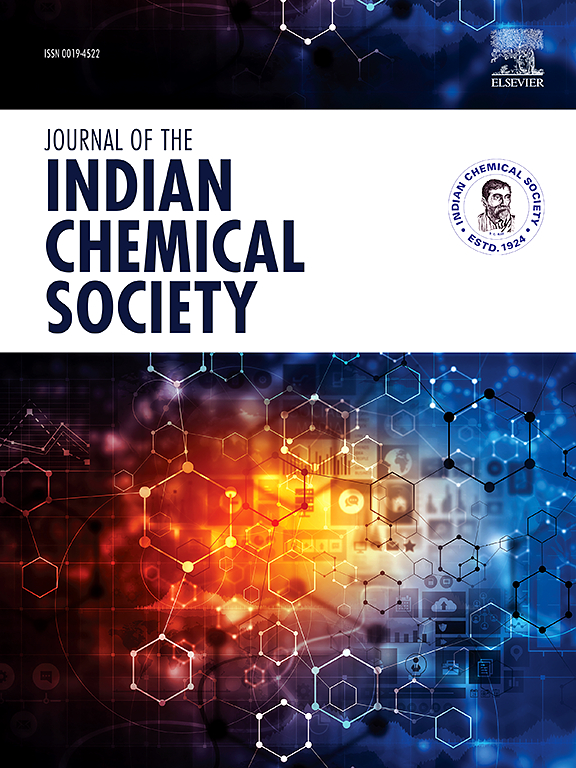基于胆固醇氧化酶纳米结构的改进型安培胆固醇生物传感器,用于心肌梗死的预诊断
IF 3.2
4区 化学
Q2 CHEMISTRY, MULTIDISCIPLINARY
引用次数: 0
摘要
胆固醇在人类健康中起着举足轻重的作用,是心血管疾病(包括心肌梗塞)的重要生物标志物。本研究介绍了一种创新型安培胆固醇生物传感器的开发情况,该传感器可提高对血清中胆固醇水平的检测和定量。该生物传感器将胆固醇氧化酶(ChOx)纳米粒子与改良电极整合在一起,利用铂纳米粒子(PtNPs)和石墨烯纳米片(GNs)的独特性能提高灵敏度和稳定性。铂纳米粒子是用山茶提取物合成的,而氧化石墨烯则被还原成 GNs。2.39毫克/毫升或以上的胆固醇被认为是心血管疾病、外周动脉疾病、心脏病、糖尿病、中风和高血压的生物标志物。因此,监测血清胆固醇水平意义重大。在本研究中,通过将胆固醇氧化酶纳米颗粒固定在用石墨烯纳米片(GNs)、铂纳米颗粒(PtNPs)和壳聚糖(CHIT)修饰的铅笔石墨(PG)电极上,构建了一种创新的安培胆固醇生物传感器。在构建的不同阶段,采用电阻抗光谱法(EIS)、循环伏安法(CV)、扫描电子显微镜(SEM)和能量色散 X 射线光谱法(EDX)对改性电极进行了表征。生物传感器在最佳 pH 值为 0.14Vs-1 和温度分别为 8.0 和 35°C 的条件下运行时反应最佳。该生物传感器的线性范围宽(0.1 毫克/毫升-7.5 毫克/毫升),灵敏度高(0.89 毫安厘米-1 毫克毫升-1),检测限低(0.97 毫克/毫升)。这项研究不仅为生物传感领域做出了贡献,还为胆固醇相关健康问题的早期诊断提供了一种前景广阔的工具,为加强心血管疾病管理铺平了道路。本文章由计算机程序翻译,如有差异,请以英文原文为准。

An improved amperometric cholesterol biosensor based on cholesterol oxidase nanostructures for pre-diagnosis of myocardial infarction
Cholesterol plays a pivotal role in human health, serving as a crucial biomarker for cardiovascular diseases, including myocardial infarction. This study presents the development of an innovative amperometric cholesterol biosensor that enhances the detection and quantification of cholesterol levels in serum. The biosensor integrates cholesterol oxidase (ChOx) nanoparticles with a modified electrode, leveraging the unique properties of platinum nanoparticles (PtNPs) and graphene nanosheets (GNs) to improve sensitivity and stability. The synthesis of PtNPs was achieved using Camellia sinensis extract, while graphene oxide was reduced to form GNs. At 2.39 mg/mL or above is deemed a biomarker for cardiovascular disorders, peripheral artery disease, heart attack, diabetes mellitus, strokes, and hypertension. The monitoring of serum cholesterol level is therefore very significant. In the present study, an innovative amperometric cholesterol biosensor was constructed by immobilizing nanoparticles of cholesterol oxidase onto a pencil graphite (PG) electrode modified with graphene nanosheets (GNs), platinum nanoparticles (PtNPs), and chitosan (CHIT). At various stages of construction, the modified electrode was characterized by employing electrical impedance spectroscopy (EIS) and cyclic voltammetry (CV), scanning electron microscopy (SEM), and energy dispersive X-ray (EDX) spectroscopy. The biosensor responded best when run at 0.14Vs-1 at optimal pH and temperature of 8.0 and 35°C respectively. The biosensor has a wide linear range (0.1mg/mL-7.5 mg/mL), with great sensitivity (0.89 mA cm−1mgmL−1) and a low limit of detection (0.97 mg/mL). This research not only contributes to the field of biosensing but also offers a promising tool for the early diagnosis of cholesterol-related health issues, paving the way for enhanced cardiovascular disease management.
求助全文
通过发布文献求助,成功后即可免费获取论文全文。
去求助
来源期刊
CiteScore
3.50
自引率
7.70%
发文量
492
审稿时长
3-8 weeks
期刊介绍:
The Journal of the Indian Chemical Society publishes original, fundamental, theorical, experimental research work of highest quality in all areas of chemistry, biochemistry, medicinal chemistry, electrochemistry, agrochemistry, chemical engineering and technology, food chemistry, environmental chemistry, etc.

 求助内容:
求助内容: 应助结果提醒方式:
应助结果提醒方式:


